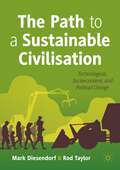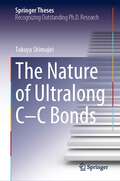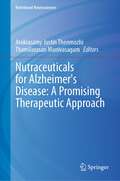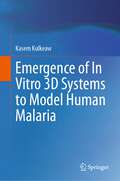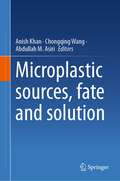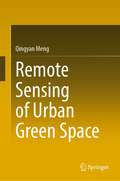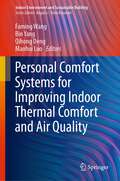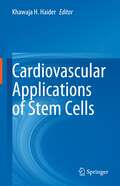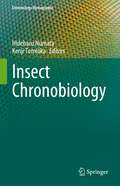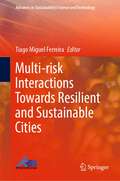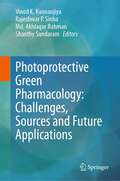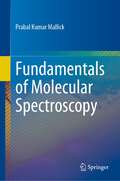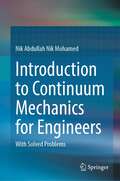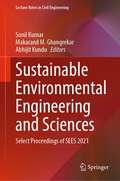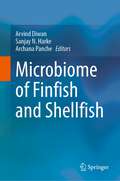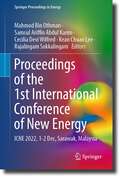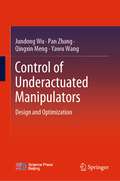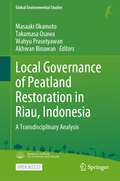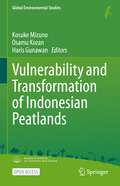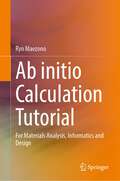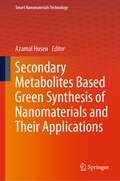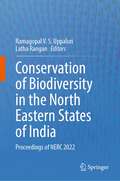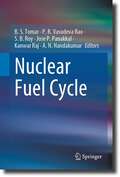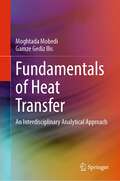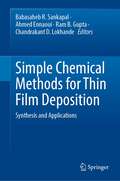- Table View
- List View
The Path to a Sustainable Civilisation: Technological, Socioeconomic and Political Change
by Mark Diesendorf Rod TaylorThe Path to a Sustainable Civilisation shows that we have unwittingly fallen into an existential crisis of our own making. We have allowed large corporations, the military and other vested interests to capture governments and influence public opinion excessively. We have created a god called ‘the market’ and allowed our most important decisions to be made by this imaginary entity, which is in fact a human system controlled by vested interests. The result has been the exploitation of our life support system, our planet, and most of its inhabitants, to the point of collapse. This book argues that the way out of our black hole is to build social movements to apply overwhelming pressure on government and big business, weaken the power of vested interests and strengthen democratic decision-making. This must be done simultaneously with action on the specific issues of climate, energy, natural resources and social justice, in order to transition to a truly sustainable civilisation.
The Nature of Ultralong C–C Bonds (Springer Theses)
by Takuya ShimajiriThis book focuses on the creation and demonstration of a carbon–carbon (C–C) single bond beyond 1.8 Å and on elucidation of its unique nature. C–C single bond is one of the most fundamental concepts in organic chemistry. The elucidation of its nature is important for further understanding chemical phenomena. The nature in the extreme state of C–C single bond is still unexplored because of the instability of compounds. In terms of its bond length, the limit had been predicted around 1.8 Å based on the experimental and theoretical studies. This book describes a first example of a C–C single bond beyond 1.8 Å by employing the original intramolecular core-shell strategy to make a weak and elongated bond stable enough. The presence of such an elongated bond was demonstrated by experimental and theoretical studies. The bond length changes could affect physical properties such as optical absorption and redox potential. Furthermore, its unique "flexibility" was discovered. This book benefits the chemists with deeper understanding of the covalent bonding.
Nutraceuticals for Alzheimer's Disease: A Promising Therapeutic Approach (Nutritional Neurosciences)
by Arokiasamy Justin Thenmozhi Thamilarasan ManivasagamThis book reviews the potential effect of diet modification, lipids, and carbohydrate consumptions, vitamin supplementation, antioxidants, and nutraceuticals in the prevention and management of Alzheimer's disease. The initial chapter of the book presents the pathophysiological mechanisms, risk factors, genetic predisposition, disease diagnosis, pathology, and current treatment strategies against Alzheimer's disease. It also highlights recent developments in exploring novel compounds for the prevention and treatment of Alzheimer's disease. Subsequently, it highlights the therapeutic effect and regulation of molecular targets by natural compounds. The book discusses the potential of natural compounds in inhibiting the formation and deposition of Aβ peptides. It examines the natural compounds in modulating intracellular signaling molecules and enzymes involved in the pathogenesis of Alzheimer's disease. In summary, this book helps understand the role of natural compounds as a therapeutic approach in amelioration and preventing detrimental effects of Alzheimer's disease.
Emergence of In Vitro 3D Systems to Model Human Malaria
by Kasem KulkeawThis book illustrates the importance and advances of the disease model for malaria, a globally affected public health problem. This book provides comprehensive information on the malaria biology in a liver and all in vitro platforms for liver-stage malaria, including principles, protocols, applications for disease modeling and drug screening, and their limitations. The initial chapter describes the basis of stem cells in liver generation during development and in adults. The subsequent chapters highlight recent and emerging advances in liver organoid and liver-on-a-chip in modeling malaria. The book presents current protocols and methods to generate liver organoid and liver-on-a-chip together with their advantages and limitations. Toward the end, the book examines the humanized mouse model of liver-stage malaria using ectopic artificial livers regarding novel readout modalities. The recent advancement and challenges in combining liver-on-a-chip technology with biosensors are highlighted for assessing hepatocyte development viability and functions. The book elucidates the potential of these 3D models to understand the biological complexity of cellular and molecular mechanisms involved in Plasmodium development in the liver, toolboxes to investigate parasite deployment in the 3D models, and to implement in drug discovery. Finally, the book discusses the future directions and challenges in the applications of liver organoids and liver on-chip in the biology of live-stage malaria. This book is helpful for researchers and scientists in the field of parasitology, cell biology, tissue engineering, and pharmacology.
Microplastic sources, fate and solution
by Anish Khan Chongqing Wang Abdullah M. AsiriThis book provides an overview of the sources, occurrence, fate and solution of microplastics. Microplastics in sediment and soil environment have been only scarcely surveyed, and no profound discussion on microplastics removal is summarized until this book. Here we focus on sharing clear schematic information and the book sufficiently supports important microplastic topics: such as microbial network, microplastic toxicology and accumulation, agricultural plastics, nylon microplastics, polystyrene microplastics, polyethylene microplastics and many more. The book mainly provides an overview of recent advances in knowledge of sources, occurrence, distribution, chemical behavior and ecological threats while it also presents information related to feasible solutions for microplastic pollution management. This comprehensive resource will be valuable up-to-date knowledge for environmental scientists, ecotoxicologists, ecologists, marine biologists, environmental chemists in the academic field and this book is intended to be beneficial information for environmental managers, water suppliers, wastewater treatment, plastics manufacturer, and policy makers as well.
Remote Sensing of Urban Green Space
by Qingyan MengThis book presents a systematic study of urban green space remote sensing from multi-dimensional and multi-scale technologies. On the basis of introducing the connotation, science and application value of urban green space, this book focuses on the two-dimensional and three-dimensional information extraction technology of urban vegetation, two-dimensional and three-dimensional measurement technology of urban green space and multi-scale perception technology and discusses the remote sensing evaluation method of urban green space. By exploring the technical advantages of ‘satellite remote sensing + aerial remote sensing + near-ground remote sensing’, urban green space remote sensing promotes the development of urban vegetation research from two-dimensional to three-dimensional observation, so that the quantity, quality and human perception of urban vegetation can be measured. In each chapter, an individual technology/method is introduced, and several cases are cited to demonstrate its practical application. This book offers a valuable reference guide for practitioners in urban planning, landscape greening, environmental protection and urban management, as well as teachers and graduate students engaged in urban remote sensing research.
Personal Comfort Systems for Improving Indoor Thermal Comfort and Air Quality (Indoor Environment and Sustainable Building)
by Faming Wang Bin Yang Qihong Deng Maohui LuoThis book first describes fundamental knowledge on human thermal comfort, adaptive thermal comfort, thermal comfort in sleeping environments, modeling of human thermal comfort, and thermal comfort assessment using human trials. Next, it presents an in-depth review of concept progress and evaluation of various personal comfort system, summarizes important findings and feasible applications, current gaps as well as future research needs. The seven chapters included in this section are task/ambient conditioning systems, personalized ventilation systems, electric fans, personal comfort systems, thermoelectric systems, personal thermal management systems, and wearable personal thermal comfort systems. This book provides valuable guidance for personal comfort system design and further improvement on the personal comfort performance. It will be a valuable resource for academic researchers, engineers in industry, and government regulators in the field of sustainable buildings and built environment.
Cardiovascular Applications of Stem Cells
by Khawaja H. HaiderThe book covers multifarious aspects of stem cell-based therapy for cardiovascular diseases. In addition to stem cells from different sources for cell-based therapy, it covers stem cell organoids and stem cell-derived exosomes in regenerative medicine. The book also encompasses advances in state-of-the-art infrastructure to improve the maturation aspects of pluripotent stem cells-derived cardiomyocytes using a novel scaffold-based cell culture system for cell delivery in experimental animal models and clinical settings. Besides the use of mesenchymal stem cells, the book includes chapters on the use of cardiac progenitor cells (CPCs), microtissue implantation, use of PSCs for valvulopathies, application of de-cellularized organ arrays as natural scaffolds for cardiac tissue engineering, use of epicardial stem cells, and skeletal myoblasts in cell-based therapy for myocardial regeneration. Besides the cell-based therapy approach, the book also reviews the stem cell-derived exosomes, their characteristics, and engineering strategies to enhance their therapeutic potential via targeting and drug loading and use in disease models. Additionally, the book also discusses the latest research on injectable hydrogels for cardiovascular regeneration and how hydrogel-based delivery protects the cells and their retention post-engraftment in the heart, a problem, which significantly reduces the efficacy of cell-based therapy.
Insect Chronobiology (Entomology Monographs)
by Hideharu Numata Kenji TomiokaThis book reviews the physiological mechanisms of diverse insect clocks, including circadian clock, lunar clock, tidal clock, photoperiodism, circannual rhythms and others. It explains the commonality and diversity of insect clocks, focusing on the recent advances in their molecular and neural mechanisms. In the history of chronobiology, insects provided important examples of diverse clocks. The first report of animal photoperiodism was in an aphid, and the time-compensated celestial navigation was first shown in the honeybee. The circadian clock was first localized in the brain of a cockroach. These diverse insect clocks also have some common features which deserve to be reviewed in a single book. The central molecular mechanism of the circadian clock, i.e., the negative feedback loop of clock genes, was proposed in Drosophila melanogaster in the 1990s and later became the subject of the Nobel Prize in Physiology or Medicine in 2017. Thereafter, researches on the molecular and neural mechanisms in diverse insect clocks other than the Drosophila circadian clock also advanced appreciably. Various new methods including RNAi, NGS, and genome editing with CRISPR-Cas9 have become applicable in these researches. This book comprehensively reviews the physiological mechanisms in diverse insect clocks in the last two decades, which have received less attention than the Drosophila circadian clock. The book is intended for researchers, graduate students, and highly motivated undergraduate students in biological sciences, especially in entomology and chronobiology.
Multi-risk Interactions Towards Resilient and Sustainable Cities (Advances in Sustainability Science and Technology)
by Tiago Miguel FerreiraFor years, researchers have studied the risks of individual natural hazards in urban areas. However, the impact of multiple hazards has not yet received widespread attention in research and urban management practice, which is a significant gap in the current climate change context. This book aims to contribute to filling that gap by examining the process of identifying, assessing, and managing multi-hazard risks in urban areas. From identifying and assessing the vulnerability of the elements exposed to the impact of natural hazards, including earthquakes, floods, fires, and landslides, this book covers all the critical stages of multi-hazard risk assessment and management in a climate change context. The concepts and approaches discussed in the book are applied to the Lisbon Metropolitan Area, a dynamic and thriving metropolis, allowing readers to see those theories applied in a real setting. In addition to providing a solid theoretical foundation, this book offers practical guidelines for conducting risk assessment at the metropolitan scale, which makes it a valuable resource for researchers, practitioners, and decision-makers interested in understanding and managing multi-hazard risks in urban areas.
Photoprotective Green Pharmacology: Challenges, Sources and Future Applications
by Vinod K. Kannaujiya Rajeshwar P. Sinha Md. Akhlaqur Rahman Shanthy SundaramThis book illustrates the role of photoprotective and radioprotective metabolites from natural sources. Various classes of radioprotective metabolites derived from cyanobacteria, algae, fungi, bryophytes, pteridophytes, gymnosperms, and higher plants have been explained to reinforce the current knowledge in this field. In addition, the book elucidates the potential applications of these metabolites in pharmaceutics, cosmetics, and biomedical sciences that will help develop commercial products in modern anti-radiation therapeutics. Topics such as stress tolerance environmental strategies, evolutionary tendency, and biosynthetic route of radioprotective compounds for cost-effective large-scale industrial production of the metabolites are also covered in the book. This book will add to the understanding of radioprotective mechanisms and curative measures for various deleterious diseases leading to cancer development. This volume also offers the latest insights into current and upcoming issues that arise from solar and atomic radiations and their amelioration by inherent radioprotective mechanisms of green plants. This book benefits readers from academia, industry, colleges, and research students to better understand the impacts of various radiations and the development of radioprotective green compounds.
Fundamentals of Molecular Spectroscopy
by Prabal Kumar MallickThis book presents detailed aspects of different fields of molecular spectroscopy. It consists of eleven chapters starting from the Born–Oppenheimer approximation and its relevance to various spectra to some topics on nonlinear spectroscopy through rotational, vibrational, Raman, and electronic spectroscopy, group theoretical application, nuclear magnetic resonance, electron spin resonance, nuclear quadrupole resonance, and Mossbauer spectroscopy. The intention is to present a good background of the theoretical aspects of the concerned fields which will help the readers to understand the subject firmly and apply them to their own fields according to their needs. For this purpose, several problems have been worked out to make the readers understand how the theories are applied in the relevant practical cases. In this book, it is presumed that the readers are well acquainted with the fundamentals of the basic subjects of physics, for example, mathematical methods, classical mechanics, quantum mechanics, statistical mechanics, and electrodynamics. The purpose of writing is not only to bring a wider field in a single book but also to develop the theories starting from the fundamentals and also from the simple to the final forms through fairly elaborate powerful techniques so that the readers become self-sufficient and apply them accordingly. Since this book covers most of the major fields of molecular spectroscopy, it reduces the work of searching several publications and serves the purpose of getting detailed deductive pictures of various aspects of the subject in a single publication.
Introduction to Continuum Mechanics for Engineers: With Solved Problems
by Nik Abdullah MohamedThis textbook provides an overview of the fundamental concepts in continuum mechanics for application in real material behavior analysis. The contents cover basic topics such as Kinematics—the motion of any material point representing a material body using the Lagrangian and Eulerian approaches; stress tensors—stress analysis of material bodies experiencing small deformations; mathematical modeling of material properties in continuum mechanics; balance principles—transfer of specific mechanical properties from a system to its environment or vice-versa through the system boundary. The textbook also contains pedagogical elements such as worked examples and end-of-chapter exercises which are derived from typical engineering problems, and the solution manual so that students can solve computational problems by running simulations on Matlab or Python on their own. This benefits engineering students understand the concept of continuum mechanics for future analysis using finite-element analysis, boundary element method or any other computational methods.
Sustainable Environmental Engineering and Sciences: Select Proceedings of SEES 2021 (Lecture Notes in Civil Engineering #323)
by Sunil Kumar Makarand M. Ghangrekar Abhijit KunduThis book presents the select proceedings of the International conference of Sustainability in Environmental Engineering and Science (SEES) 2021. It presents the latest developments in civil engineering that cover all aspects and challenges in civil engineering, environmental engineering and environmental science. Various topics covered in this book include construction and structural mechanics, building materials, concrete, steel and timber structures, geotechnical engineering, earthquake engineering, and coastal engineering. The volume will be useful for beginners, researchers, and professionals working in the areas of sustainable civil engineering and related fields.
Microbiome of Finfish and Shellfish
by Arvind Diwan Sanjay N. Harke Archana PancheThis book helps us to understand the importance of the microbiome associated with finfish and shellfish inhabiting different locations and varied environmental and biological situations. It covers modern molecular tools for identifying microbiome composition and their precise identification at the species level. The book also covers the molecular structural composition of individual microbes, metabolite resources from microbiome species, their functional properties, and production aspects. Notable, the book covers the microbiome applications in the gut systems of finfish and shellfish to the digestion, nutrition, growth, reproduction, immune system, and vulnerability of the host to diseases. It also reviews diversity and functional properties, relationships with diseases, health status, data on species-specific metagenomics, and probiotic research. It highlights the relevance of microbial communities for the development of new and innovative bio-products to build bio and pharmaceutical industries, including aquaculture. This book is an invaluable source for researchers and professionals involved in fishery science, fisheries and aquaculture, fish biotechnology, and fish microbiology and pathology
Proceedings of the 1st International Conference of New Energy: ICNE 2022, 1-2 Dec, Sarawak, Malaysia (Springer Proceedings in Energy)
by Mahmod Bin Othman Samsul Ariffin Abdul Karim Cecilia Devi Wilfred Kean Chuan Lee Rajalingam SokkalingamThis book presents peer-reviewed articles from the 1st International Conference on New Energy (ICNE 2022), held on 1–2 December at Sarawak in Malaysia. This book highlights the current trends/studies on fundamental of hydrogen technologies and the application of hydrogen as the new sustainable renewable energy. Topics included but not limited to are: hydrogen production, its storage and transportation, and hydrogen utilization. This book contributes in making green hydrogen competitive and ready for a scale up in the 2030s, towards the objective of reaching net zero emissions by 2050
Control of Underactuated Manipulators: Design and Optimization
by Jundong Wu Pan Zhang Qingxin Meng Yawu WangThis book investigates in detail cutting-edge technologies of underactuated manipulator control, which is a frontier topic in robotics that possesses great significance in energy conservation as well as fault tolerance for industrial applications. It is also the crucial technology associated with systems in special environments, including underwater or aerospace environments. So far, the topic of underactuated manipulator control has attracted engineers and scientists from various disciplines, such as applied physics, material, automation and robotics. Pursuing a holistic approach, the book establishes a fundamental framework for this topic, while emphasizing the importance of design and optimization in the control of underactuated manipulators. Chapters of the book cover a wide variety of manipulator systems, including vertical underactuated manipulator, planar underactuated manipulator with first-order nonholonomic constraint, planar underactuated manipulator with second-order nonholonomic constraint and flexible underactuated manipulator. The book is intended for undergraduate and graduate students that are interested in underactuated manipulators, researchers that investigate the design and optimization for controllers of underactuated manipulators and engineers working with underactuated systems.
Local Governance of Peatland Restoration in Riau, Indonesia: A Transdisciplinary Analysis (Global Environmental Studies)
by Masaaki Okamoto Takamasa Osawa Wahyu Prasetyawan Akhwan BinawanThis open access book is one in a series of four volumes introducing peatland conservation and restoration in Indonesia. It focuses on local governance, in particular on regional and local perspectives in Riau, the most peat-destructed province of Indonesia. The book fills a vital gap in the existing literature that overlooks social science and humanities perspectives. Written by authors from different disciplines and backgrounds (including scholars and NGO activists), the approaches to the topic are various and unique, including analysis of GPS logs, social media, geospatial assessments, online interviews (conducted due to the Covid-19 pandemic), and more conventional questionnaires and surveys of community members. The chapters cover an interdisciplinary understanding of peatland destruction and broadly offer insights into environmental governance. While presenting combined studies of established fieldwork methodologies and contemporary technology such as drones and geospatial information, the book also explores the potential of long-distance research with rural communities through online facilitation, which was brought about by Covid-19, but that may have longterm implications. Readers will gain a comprehensive understanding of the complexities surrounding peatland conservation and restoration and recognize the significance of locally inclusive approaches that use contemporary but accessible technologies to sustainably govern the globally important resource of peatland. That approach would be useful for other environmentally fragile but important regions and give some ideas to achieve the United Nations’ SDGs for 1)No Poverty, 5)Gender Equality, 13)Climate Action, 15)Life of Land.
Vulnerability and Transformation of Indonesian Peatlands (Global Environmental Studies)
by Kosuke Mizuno Osamu Kozan Haris GunawanThis open access book deals with restoring degraded peatlands to help mitigate global warming, to which SDG 15 and SDG 13 are directly related. The book analyzes peatland degradation and restoration of the Indonesian peatland ecosystem through the integrated lens of resilience, vulnerability, adaptation, and transformation. It sheds light on what constitutes "resilience" of the peat swamp forest, digs deeper into local knowledge in developing the studies on institutions, governance, and ecological conditions that support the resilience of the peat swamp forest to elaborate on the idea of transformation in today's degraded peatlands. While peat swamp forests may be resilient, they remain highly vulnerable. The book analyzes restoration efforts through rewetting, revegetation, and rehabilitation of the local livelihoods with the concepts of adaptation and transformation. The integrated analysis covers fieldwork of more than a decade and various aspects such as agrarian and social changes, biological changes (birds, mammals, and termites), carbon emission, water control, timber use, revegetation efforts, and the Indonesia Sustainable Palm Oil (ISPO) program implementation. It also employs the ideas of vulnerability, resilience, adaptability, and transformation based on expanded studies on peatlands and observations of and participation in multiple efforts to prevent fires and restore the degraded peatland by researchers, the government, non-government organizations (NGOs), private companies, and last but not least, the local people. The discussion includes the period of pre-degradation and several efforts at peatland restoration for a better understanding and analysis of the long-term peatland dynamics.
Ab initio Calculation Tutorial: For Materials Analysis, Informatics and Design
by Ryo MaezonoThis textbook covers the framework of first-principles analysis applied to materials using density functional theory (DFT). It provides a set of hands-on tutorials using the Quantum ESPRESSO package, an open-source software for DFT. The tutorials are well chosen, designed for maximum effectiveness while requiring a minimum of the reader’s time, and the book describes how the essential components are combined to create the practical applications based on the idea of modeling practical problems of materials. The book carefully explains how to prepare the platform to run the tutorials assisted by free software. This textbook is useful for students in experimental laboratories, for industrial researchers, and for those not majoring in theoretical studies but learning individually.
Secondary Metabolites Based Green Synthesis of Nanomaterials and Their Applications (Smart Nanomaterials Technology)
by Azamal HusenNanotechnology is gaining importance in every field of science and technology. Green synthesis of nanomaterials involves the use of microorganisms such as bacteria, fungi, viruses; and different lower and higher plants. Green synthesis of nanomaterials from plant extracts becoming popular in comparison to synthesis using microorganisms. Plant based-nanomaterials synthesis is easy, have no need to bring back from the culture medium, and is safe. Additionally, plant-based nanomaterials are eco-friendly, in comparison to physical and chemical modes of synthesis. Several lower and higher plants are rich in terms of secondary metabolites. These metabolites have been used as medicine in crude extract form or with some other formulations. They have been also used to isolate the bioactive compounds in modern medicine as well as in herbal medicine systems. Thus, phytochemicals present in the plant and their parts play an important role in nanomaterials synthesis, mainly due to the presence of a significant number of secondary metabolites, for instance, alkaloids, flavonoids, saponins, steroids, tannins, etc. Further, essential and aromatic oils have been also explored for nanomaterials synthesis, and they are also equally useful in terms of their various biological applications. These organic ingredients come from a wide range of plant components, such as leaves, stems, roots, shoots, flowers, bark, and seeds. Globally, the presence of different plants has shown a capability to produce huge and diverse groups of secondary metabolites. The functional groups present in the plant extract acts as capping and stabilizing agent. Most of the time, pure isolated bioactive compounds are more biologically active; hence scholars are focusing their research on the synthesis of nanomaterials using some particular class of secondary metabolites. Investigations have shown that the green synthesized nanomaterials were found to be more biologically active in comparison to chemically synthesized nanomaterials. These nanomaterials and or nanocomposites found different applications especially in drug delivery, detection and cure of cancer cells, diagnosis of a genetic disorder, photoimaging, and angiogenesis detection. They have also shown several applications in agricultural, horticultural as well as forestry sectors. The book in hand covers a wide range of topics as mentioned above. It incorporates chapters that the authors have skilfully crafted with clarity and precision, reviewing up-to-date literature with lucid illustrations. The book would cater to the need of graduate students as a textbook and simultaneously be useful for both novices and experienced scientists and or researchers working in the discipline of nanotechnology, nanomedicine, medicinal plants, plant science, economic botany, chemistry, biotechnology, pharmacognosy, pharmaceuticals, industrial chemistry, and many other interdisciplinary subjects. It should also inspire industrialists and policy makers associated with plant-based nano products.
Conservation of Biodiversity in the North Eastern States of India: Proceedings of NERC 2022
by Ramagopal V. S. Uppaluri Latha RanganThis volume presents part of the proceedings of NERC 2022, with an emphasis on conservation of bio-diversity in North-east India. This is a highly challenging and involved topic due to regionally diverse physiographic, geographical and eco-climatic conditions. Henceforth, systemic and holistic frameworks are required to disseminate upon the potential of science and technology for the conservation of the region’s bio-diversity. Notable among these frameworks refers to plant, microbial and animal bio-diversity conservation, value-added product development and sharing the benefits of such research for the perspective of bio-prospects, analysing critical environmental and climatic factors and their sensitivity upon urbanization strategies. Tools that are to be deployed for such insights involve plant, animal, and microbial bioscience and biotechnology, generalized rules for product design and development and survey based strategies. Addressing relevant competent methodologies and generic pedagogies, this volume on the bio-diversity conservation in North-eastern states of India aims to demonstrate the potential of pragmatic strategies that can be applied for the bio-diversity conservation in any region of world. Thereby, opportunities for nature linked livelihood security can be sought for the long term wellbeing of the humankind and ecology.
Nuclear Fuel Cycle
by B. S. Tomar P. R. Vasudeva Rao S. B. Roy Jose P. Panakkal Kanwar Raj A. N. NandakumarThe present book describes the various processes involved in different stages of the entire nuclear fuel cycle, which include exploration of uranium, thorium, and other nuclear materials, mining and milling of ores, conversion of the separated nuclear material into nuclear grade, fabrication of different types of nuclear fuels and their physical as well as chemical quality control, thermodynamics of the interaction among fuel and fission products during reactor operation, post irradiation examination, spent fuel reprocessing, radioactive waste management, accounting and control of nuclear materials, and safety aspects involved in handling and transportation of nuclear materials. The book provides the fundamental knowledge to the practicing nuclear scientists and engineers, young researchers, and postgraduate students interested in pursuing a career in nuclear industry in general and those engaged in human resource development in the field of nuclear science and technology in particular. It can also be prescribed as a textbook for a course on nuclear fuel cycle at postgraduate level.
Fundamentals of Heat Transfer: An Interdisciplinary Analytical Approach
by Moghtada Mobedi Gamze Gediz IlisThis book demonstrates the analytical solution of fundamental problems in heat transfer which covers conduction, convection, and radiation heat transfer. The analytical solution of heat transfer problems is described in a simple way which is easy to understand. This book also provides competence of solving fundamental heat transfer problems by analytical method which is particularly important to gain a strong background on heat transfer. The book is an interdisciplinary heat transfer book which is useful for all academicians and students from different disciplines with different levels of mathematical knowledge. The book can be used as a core or supplementary textbook in undergraduate and graduate bridge courses. Furthermore, it is suitable for professional and vocational coursework for technology and engineering professionals.
Simple Chemical Methods for Thin Film Deposition: Synthesis and Applications
by Babasaheb R. Sankapal Ahmed Ennaoui Ram B. Gupta Chandrakant D. LokhandeThis book explores chemical methods for thin film deposition with diverse nanostructured morphology and their applications. Unlike top-down techniques, chemical methods offer low cost, simplicity, and growth of nanostructured surface architecture with ease of small to large-scale area deposition. The book primarily focuses on innovative twelve chemical methods for thin-film deposition on one platform. Since each method has its own advantages and disadvantages, it is crucial to select the specific method for specific material to be deposited depending upon what type of application is targeted. Due to inclusive of diverse chemical deposition methods, researcher will have knowledge about best choice of the deposition method to be adopted. Inclusive methods discussed in the book are chemical bath deposition, successive ionic layer adsorption and reaction, ion exchange, electroless deposition, electrodeposition, hydrothermal, spray pyrolysis, spin coating, dip coating, doctor blade, screen printing, and sol-gel.The selection of the correct procedure for material to be deposited in thin film form depends on its unique process parameters based on the kind of application and its requirement. The role of preparative factors necessary for thin film alters properties related to structure and surface morphology, electrical conductivity and optical band gap which have been extensively discussed along with the underlying science of film synthesis. The book provides a comprehensive overview of the field of chemical methods for thin film synthesis to applications. In addition to synthesis, the book covers characterization, instrumentation, and industrial application of thin films. As a result, concentrated techniques will be of great interest to university/college professors, students and new engineers as well as postdocs and scientists in the area.
